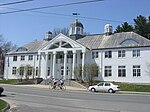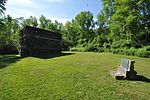Bridge No. 2305
Bridges completed in 1873Bridges in Litchfield County, ConnecticutBridges of the United States Numbered Highway SystemBridges on the National Register of Historic Places in ConnecticutNational Register of Historic Places in Litchfield County, Connecticut ... and 4 more
Road bridges in ConnecticutSalisbury, ConnecticutStone arch bridges in the United StatesU.S. Route 44

Bridge No. 2305, also known locally as the Burton Brook Bridge, is a historic bridge carrying U.S. Route 44 (US 44; Main Street) over Burton Brook in the Lakeville village of Salisbury, Connecticut. Built in 1873, this masonry arch bridge is a rare surviving example in the state of a typical late-19th century road bridge. It was listed on the National Register of Historic Places in 2007.
Excerpt from the Wikipedia article Bridge No. 2305 (License: CC BY-SA 3.0, Authors, Images).Bridge No. 2305
Bissell Street,
Geographical coordinates (GPS) Address Nearby Places Show on map
Geographical coordinates (GPS)
| Latitude | Longitude |
|---|---|
| N 41.967777777778 ° | E -73.439444444444 ° |
Address
Bissell Street 5
06039
Connecticut, United States
Open on Google Maps







